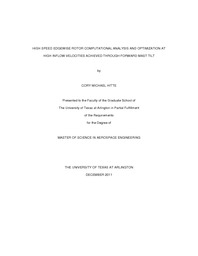| dc.description.abstract | Increased forward flight speed has long been the desire of the rotorcraft industry. Novel designs, such as compounds and tilt rotors have allowed for speed envelope expansion, but not without incurring performance hindrances unique to each configuration. Designs that utilize low disc loading edgewise rotors, which offer efficient flight at high speeds while maintaining hover performance, are desirable. Such designs require increased flapping capability and/or mast tilt in order to achieve the necessary thrust orientation required for overcoming aircraft drag. The combination of speed and thrust vector inclination yields a relatively undocumented region of rotorcraft performance. In particular, the effects of forward mast inclination, and the subsequent high airflow ingestion or "inflow", requires further analysis for accurate performance prediction.This thesis presents a recently developed analytical tool meant to capture rotor aerodynamic performance throughout the flight regime with particular attention paid to analysis of the effects of mast angle inclination and subsequent inflow at high speed. MATLAB® Version 7 was used in conjunction with wind tunnel generated compressible NACA airfoil tables to create a modified Blade Element Model (BEM). The BEM is capable of conducting compressible rotor analysis at all speeds, ambient air conditions, mast angles, and geometries. Model validation to known historical data is presented. A baseline rotor geometry was selected and subjected to sweeps of mast angle from 0 to 30 degrees and speed from 0 to 250 knots and the performance was determined. The degradation of available baseline rotor thrust as a function of speed is illustrated. Power coefficients (profile, induced, and total), H-force coefficient, peak blade torsional moments, and required control inputs as a function of thrust coefficient are presented. Additionally, a design parameter trade study is presented illustrating the concurrent effects on high speed performance of varying tip speed, solidity, number of blades, and radius. | en_US |

